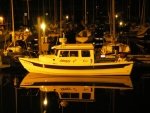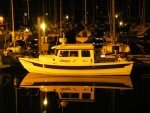My thought, whatever you do, isolate your starting battery from your house battery or batteries with a VSR (voltage sensing relay). Your alternator connects to the VSR, which connects to both starting and house batteries. The VSR fully charges your starting battery first, and when it senses the starting battery is fully charged, it automatically switches over to charging the house battery or batteries. You never want to be in a situation where your battery usage has left you unable to start your engine! It is a "smart" battery switch for charging!
As far as batteries go, let your cruising style and budget determine what you get. You definitely want deep cycle batteries for the house. There are two ratings on batteries (forget about "cold cranking amps," that is an automobile thing). What you really want to know is amp hours (AH). If your battery or batteries are rated in reserve capacity (RC), divide by 2.4 to get a rough and apparently conservative converstion to AH. You want to know how much of your battery's AHs your boat's load will use up when the engine is not running. Our house batteries are two NAPA Premium Deep Cycle RV/Marine batteries, with an estimated 133 AHs. When we need new batteries we will probably get AGM batteries with considerably more AHs. We have a freezer and spend a lot of time on the hook. The freezer, lights and a little fan for our Airhead typically uses 20 AHs overnight.
You need to consider your own particular power needs. Say you have a fridge, with a 5 amp rating and a 50% duty cycle. It runs for 10 hours before your recharge. It is going to use up 25 AHs overnight (5 amps x 0.5 x 10). The number of AHs in your house battery or batteries will determine the state of charge (SOC) in the morning. You do not want to run your house battery completely down! So the more AHs you have the better your SOC will be with any given load. If you only have lights, and they are LED, then your power requirements will be a LOT less!
By me, a Victron Battery Monitor, or comparable battery monitor, is a very worthwhile investment if you really want to know what is going on with your power usage and you have any appreciable load. In my case, since I have solar panels, it also tells me how many AHs I have restored to my house batteries as well as how many I have used, and gives me SOC at any given moment. I really am loving my Victron!
We anchor out almost all the time, and even at a dock now, like Barry, we don't use shore power, so knowing what the state of our batteries is pretty important to us.



